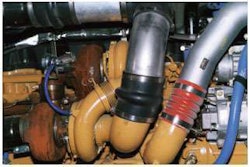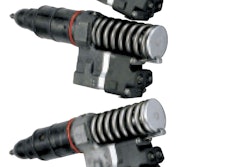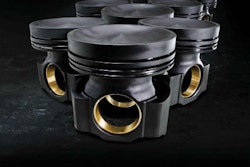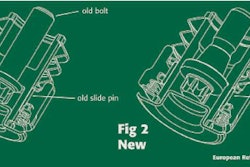
Lubricant storage decisions can protect fluids, the environment and shop productivity.
There are plenty of buying decisions behind the lubricants found in a service bay, but some of the most important questions need to be answered long before the first drop is ever dispensed.
The choice and location of a shop’s favored storage options are certain to play a key role in protecting the integrity of the supplies – in other words, keeping nasty contaminants out of the mix – and can even help to improve the productivity of those who will use the lubricants. Following are tips for keeping your lubricants optimally stored.
1. Remember that size matters
The first consideration when choosing between one storage option and the next will be to determine the volumes of lubricants that are being consumed. Tanks are usually sized on the basis on the number of services that are performed in a month. A shop that consumes 1,000 gallons will have different needs than its counterpart that pumps out 300 gallons during the same period.
“The bottom line is they don’t want to run out,” says Dan Arcy, the OEM technical manager with Shell Global Solutions.
As important as the size of the tank can be, however, shops also need to consider exactly where the lubricant is being used.
“Are they doing all their lubricating on site or is some of it in the field?” Arcy asks as an example. During the audit of one business, he found gear oil drums scattered across several sites. And many of them were three-fourths full. The better option in this case came in the form of a centralized bulk tank that was used to fill intermediate totes stored on the service department’s trucks. Instead of pulling from a barrel at a job site, technicians now load up the 40 to 50 gallons of gear oil, hydraulic oil and engine oil they will need on a particular call.
After all, fewer barrels equate to lower inventory costs.
2. Centralize the supplies
“Going through a central system to the lube area always tends to work best,” Arcy adds, noting how that will limit the chance of contamination, and limit the amount of waste material in the form of used cartridges.
The size of the pumps needed to make these central systems a reality will be dictated by a combination of the product, the distance that it needs to be pumped and the temperatures to which the lubricant is exposed.
“You’re going to be frustrated if it’s barely coming out or not coming out at all,” Arcy says.
3. Know that every option has pros and cons
Some of the most common storage options come in the form of aboveground storage tanks that are located outside the shop area. This is for a good reason. Tanks would take up valuable real estate on a shop floor, and the aboveground locations are easier to service than their buried counterparts.
Underground storage tanks have certainly been fading away in the face of tougher environmental regulations. According to the U.S. Environmental Protection Agency (EPA), there are now 611,000 of these tanks under American soil. Put this into the context that there were more than two million underground tanks in 1988, just before tighter regulations began to require upgrades and replacements to address the threat of leaks.
That being said, the aboveground storage solutions have environmental requirements of their own. The EPA, for example, always requires a secondary containment system such as a containment pan which will need to be large enough to hold 10 percent of the overall volume of a group of containers and be equal to the volume of the largest container in the mix.
Shops also need to consider the functional issues that arise if the tank is outside.
“If you’re in a colder climate, it’s going to take more energy to pump it if it gets cold,” Arcy observes, referring to the challenge of some outdoor models. That reality could require larger pump motors which will inevitably consume more energy. “And the farther you have to pump it, the more energy it’s going to take.”
4. Keep it clean
Since lubricants help to limit the impact of contamination in heavy equipment, there should be little surprise that the lubricant supplies need to be kept clean themselves. A series of housekeeping efforts will play a role in limiting the presence of any water or debris.
The cleaning of the tank will be particularly important when introducing a new category of lubricant. “Take it right down to no fluid in it and rinse it out to make sure there is no debris,” Arcy says, suggesting that the process should take place every two to three years. The rest of the time, tanks should be topped off before they drop below 20 percent of their capacities, unless they incorporate designs that always draw oil from the bottom of the tank.
Just keep in mind that some potential contaminants may be less traditional than others.
“I’ve seen things over my years where tanks have been emptied, and for some reason, some how, a rag has gotten into it. For some reason, some how, a soda can has gotten into it,” he says. Any tank lids need to be closed and secured for that very reason.
5. Store the drums properly
“Proper drum storage can make a big difference in [preventing] the contamination of the product,” Arcy adds. That will usually mean ensuring that drums are not stored vertically.
As the saying suggests, water will always find a way. Any rain will migrate through the smallest openings. “As the temperature changes you get hot and cold, you can cause some expanding and contracting,” he explains, noting how that could draw water down into the bung.
The issue can be solved by using a plastic drum comforter, or stacking the drums on their side so the bung holes are horizontal. “They [the bung holes] are going to be covered by oil inside the drum. There’s no way for water to collect on the top.”
6. Analyze the contents
Some of the new lubricant will be used in response to the results from an oil analysis program. Is there any question that every lubricant supply deserves an analysis program of its own?
“It does give you the ability to detect if you have a problem with your system,” Arcy says. “If somebody were to leave a cover off a tank, you can get some contamination in there.”
7. Label the tanks
Tanks obviously need to be labeled to offer warnings in the event of an emergency like a fire or leak, but the decals also can play a role in shop sales.
Properly branded, an identified tank can help a facility to enforce the fact that it uses a premium product. “That way, people know what’s in there,” Arcy says.
8. Weigh your options … literally
The concept of portability can be a matter of opinion. A 55-gallon drum of grease can be moved across the shop floor, but the 400-pound weight will ensure that it is no easy task. The work could lead to strain-related injuries.
It is one of the reasons that small containers still can play a role on the shop floor. A single-use container in the form of a quart or gallon of lubricant still can make sense when working with a specialized formula.
Use these tips and you can help ensure you service vehicles with the best possible quality lubricant in the most efficient manner possible. n










